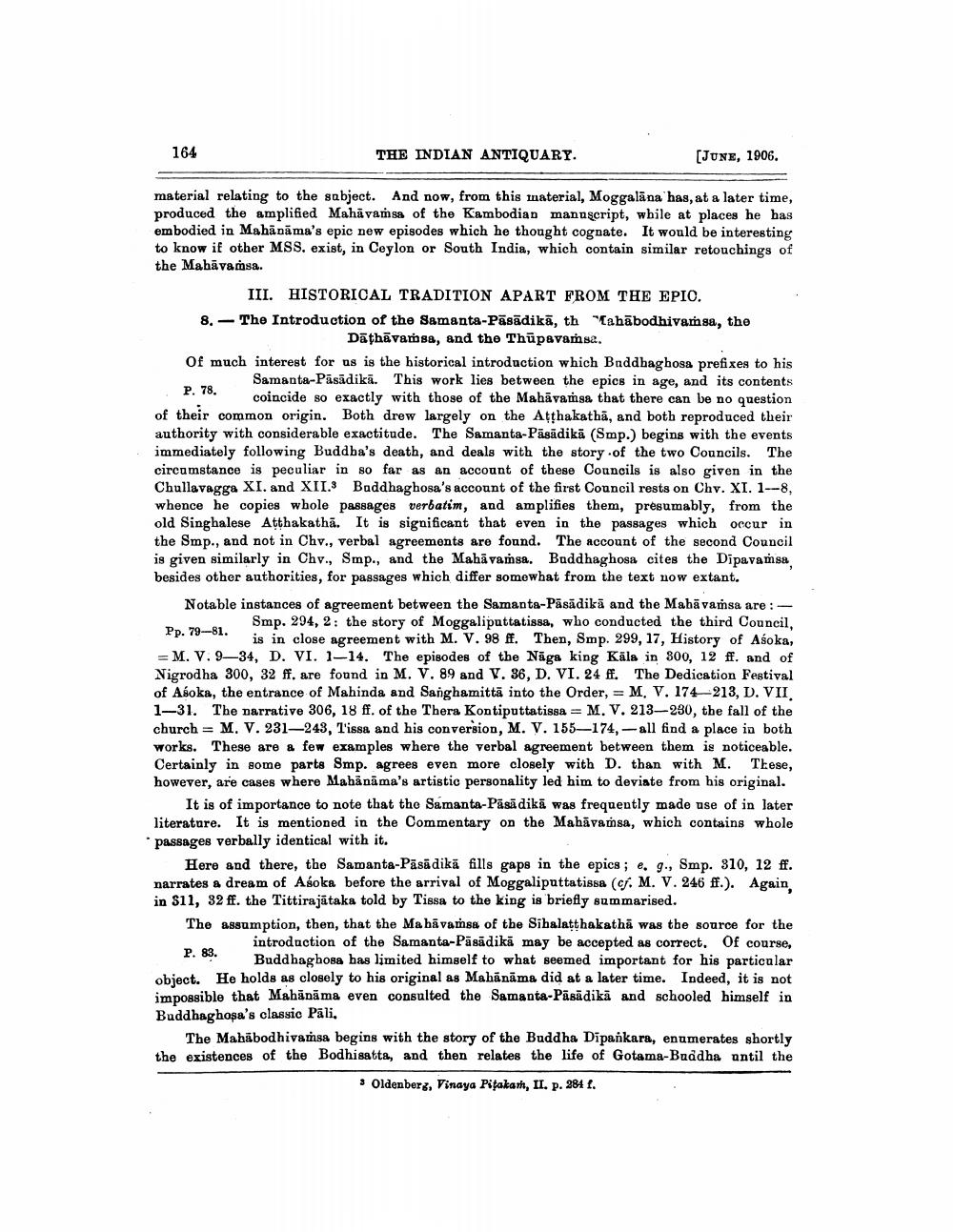________________
164
THE INDIAN ANTIQUARY.
[JUNE, 1906.
material relating to the subject. And now, from this material, Moggalana has, at a later time, produced the amplified Mahāvamsa of the Kambodian manuscript, while at places he has embodied in Mahanama's epic new episodes which he thought cognate. It would be interesting to know if other MSS. exist, in Ceylon or South India, which contain similar retouchings of the Mahāvamsa.
III. HISTORICAL TRADITION APART FROM THE EPIC.
8. The Introduction of the Samanta-Pasādikā, th Mahabodhivamsa, the Dāṭhāvamsa, and the Thupavamsa.
P. 78.
Of much interest for us is the historical introduction which Buddhaghosa prefixes to his Samanta-Päsädika. This work lies between the epics in age, and its contents coincide so exactly with those of the Mahavamsa that there can be no question of their common origin. Both drew largely on the Atthakatha, and both reproduced their authority with considerable exactitude. The Samanta-Pasādikā (Smp.) begins with the events immediately following Buddha's death, and deals with the story of the two Councils. The circumstance is peculiar in so far as an account of these Councils is also given in the Chullavagga XI. and XII. Buddhaghosa's account of the first Council rests on Chv. XI. 1-8, whence he copies whole passages verbatim, and amplifies them, presumably, from the old Singhalese Atthakatha. It is significant that even in the passages which occur in the Smp., and not in Chv., verbal agreements are found. The account of the second Council is given similarly in Chv., Smp., and the Mahavamsa. Buddhaghosa cites the Dipavamsa besides other authorities, for passages which differ somewhat from the text now extant.
Notable instances of agreement between the Samanta-Pasadika and the Mahavamsa are:Smp. 294, 2: the story of Moggaliputtatissa, who conducted the third Council, Pp. 79-81. is in close agreement with M. V. 98 ff. Then, Smp. 299, 17, History of Asoka, =M. V. 9-34, D. VI. 1-14. The episodes of the Naga king Kala in 300, 12 ff. and of Nigrodha 300, 32 ff. are found in M. V. 89 and V. 36, D. VI. 24 ff. The Dedication Festival of Asoka, the entrance of Mahinda and Sanghamitta into the Order, M, V. 174-213, D. VII 1-31. The narrative 306, 18 ff. of the Thera Kontiputtatissa M. V. 213-230, the fall of the church M. V. 231-243, Tissa and his conversion, M. V. 155-174,-all find a place in both works. These are a few examples where the verbal agreement between them is noticeable. Certainly in some parts Smp. agrees even more closely with D. than with M. These, however, are cases where Mahānāma's artistic personality led him to deviate from his original.
=
=
It is of importance to note that the Samanta-Pasadika was frequently made use of in later literature. It is mentioned in the Commentary on the Mahavamsa, which contains whole passages verbally identical with it.
Here and there, the Samanta-Pasa dikā fills gaps in the epics; e. g., Smp. 310, 12 ff. narrates a dream of Asoka before the arrival of Moggaliputtatissa (cf. M. V. 246 ff.). Again, in $11, 32 ff. the Tittirajataka told by Tissa to the king is briefly summarised.
P. 83.
The assumption, then, that the Mahavamsa of the Sihalatṭhakatha was the source for the introduction of the Samanta-Pasadika may be accepted as correct. Of course, Buddhaghosa has limited himself to what seemed important for his particular object. He holds as closely to his original as Mahānāma did at a later time. Indeed, it is not impossible that Mahānāma even consulted the Samanta-Pasādikā and schooled himself in Buddhaghosa's classic Pāli
The Mahabodhivamsa begins with the story of the Buddha Dipankara, enumerates shortly the existences of the Bodhisatta, and then relates the life of Gotama-Buddha until the 3 Oldenberg, Vinaya Pitakam, II. p. 284 f.




